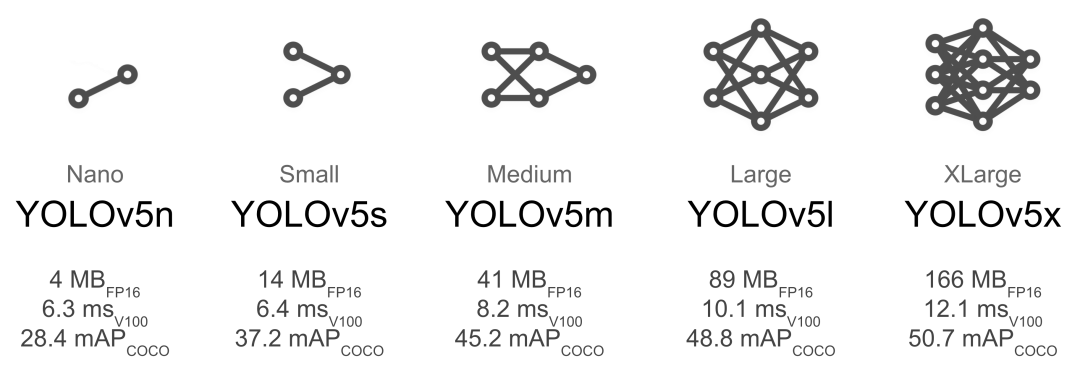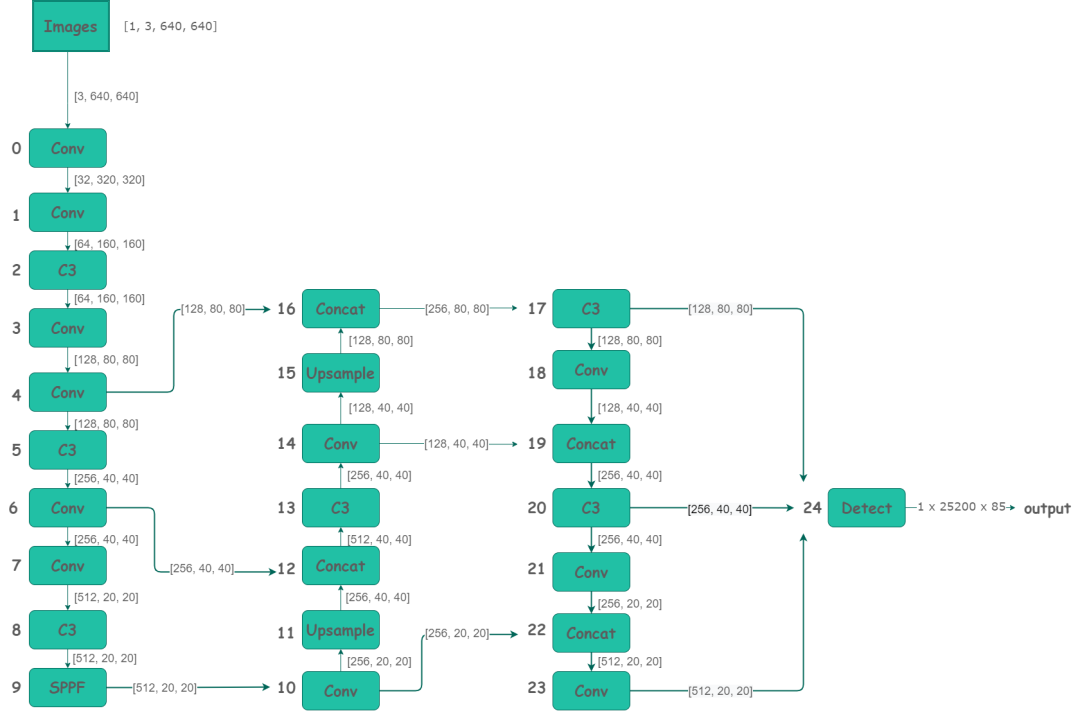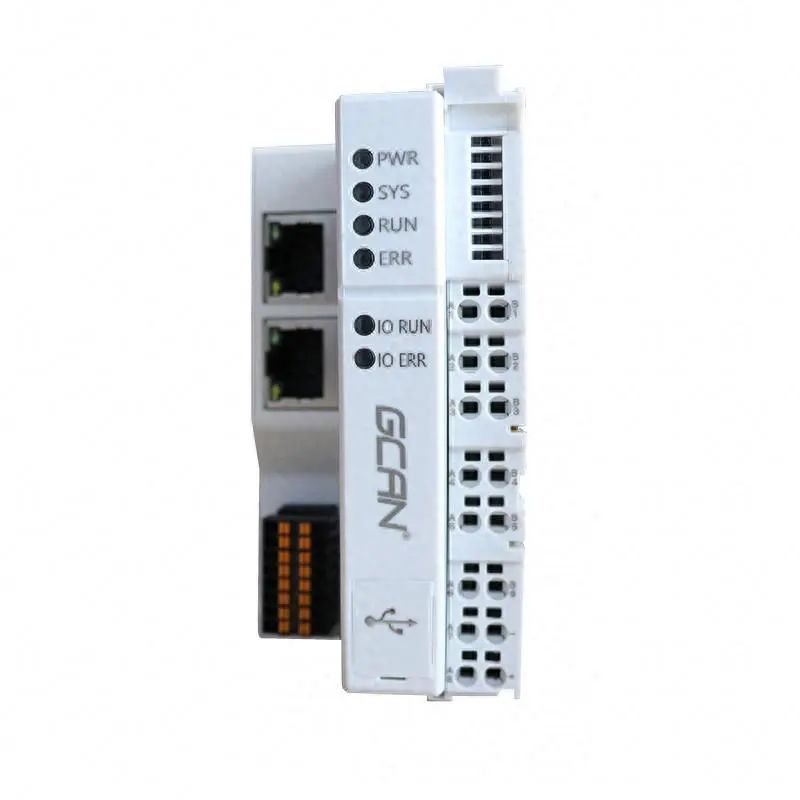本教程涉及到的代码在 https://github.com/Oneflow-Inc/one-yolov5 ,教程也同样适用于 ultralytics/yolov5 因为 one-yolov5 仅仅是换了一个运行时后端而已,计算逻辑和代码相比于 ultralytics/yolov5 没有做任何改变,欢迎 star 。详细信息请看One-YOLOv5 发布,一个训得更快的YOLOv5
YOLOv5 网络结构解析
引言
YOLOv5针对不同大小(n, s, m, l, x)的网络整体架构都是一样的,只不过会在每个子模块中采用不同的深度和宽度,
分别应对yaml文件中的depth_multiple和width_multiple参数。
还需要注意一点,官方除了n, s, m, l, x版本外还有n6, s6, m6, l6, x6,区别在于后者是针对更大分辨率的图片比如1280x1280,
当然结构上也有些差异,前者只会下采样到32倍且采用3个预测特征层 , 而后者会下采样64倍,采用4个预测特征层。
本章将以 yolov5s为例 ,从配置文件 models/yolov5s.yaml(https://github.com/Oneflow-Inc/one-yolov5/blob/main/models/yolov5s.yaml) 到 models/yolo.py(https://github.com/Oneflow-Inc/one-yolov5/blob/main/models/yolo.py) 源码进行解读。
yolov5s.yaml文件内容:
nc:80#numberofclasses数据集中的类别数
depth_multiple:0.33#modeldepthmultiple模型层数因子(用来调整网络的深度)
width_multiple:0.50#layerchannelmultiple模型通道数因子(用来调整网络的宽度)
#如何理解这个depth_multiple和width_multiple呢?它决定的是整个模型中的深度(层数)和宽度(通道数),具体怎么调整的结合后面的backbone代码解释。
anchors:#表示作用于当前特征图的Anchor大小为xxx
#9个anchor,其中P表示特征图的层级,P3/8该层特征图缩放为1/8,是第3层特征
-[10,13,16,30,33,23]#P3/8,表示[10,13],[16,30],[33,23]3个anchor
-[30,61,62,45,59,119]#P4/16
-[116,90,156,198,373,326]#P5/32
#YOLOv5sv6.0backbone
backbone:
#[from,number,module,args]
[[-1,1,Conv,[64,6,2,2]],#0-P1/2
[-1,1,Conv,[128,3,2]],#1-P2/4
[-1,3,C3,[128]],
[-1,1,Conv,[256,3,2]],#3-P3/8
[-1,6,C3,[256]],
[-1,1,Conv,[512,3,2]],#5-P4/16
[-1,9,C3,[512]],
[-1,1,Conv,[1024,3,2]],#7-P5/32
[-1,3,C3,[1024]],
[-1,1,SPPF,[1024,5]],#9
]
#YOLOv5sv6.0head
head:
[[-1,1,Conv,[512,1,1]],
[-1,1,nn.Upsample,[None,2,'nearest']],
[[-1,6],1,Concat,[1]],#catbackboneP4
[-1,3,C3,[512,False]],#13
[-1,1,Conv,[256,1,1]],
[-1,1,nn.Upsample,[None,2,'nearest']],
[[-1,4],1,Concat,[1]],#catbackboneP3
[-1,3,C3,[256,False]],#17(P3/8-small)
[-1,1,Conv,[256,3,2]],
[[-1,14],1,Concat,[1]],#catheadP4
[-1,3,C3,[512,False]],#20(P4/16-medium)
[-1,1,Conv,[512,3,2]],
[[-1,10],1,Concat,[1]],#catheadP5
[-1,3,C3,[1024,False]],#23(P5/32-large)
[[17,20,23],1,Detect,[nc,anchors]],#Detect(P3,P4,P5)
]
anchors 解读
yolov5 初始化了 9 个 anchors,分别在三个特征图(feature map)中使用,每个 feature map 的每个 grid cell 都有三个 anchor 进行预测。分配规则:
-
尺度越大的 feature map 越靠前,相对原图的下采样率越小,感受野越小,所以相对可以预测一些尺度比较小的物体(小目标),分配到的 anchors 越小。
-
尺度越小的 feature map 越靠后,相对原图的下采样率越大,感受野越大,所以可以预测一些尺度比较大的物体(大目标),所以分配到的 anchors 越大。
-
即在小特征图(feature map)上检测大目标,中等大小的特征图上检测中等目标, 在大特征图上检测小目标。
backbone & head解读
[from, number, module, args] 参数
四个参数的意义分别是:
- 第一个参数 from :从哪一层获得输入,-1表示从上一层获得,[-1, 6]表示从上层和第6层两层获得。
- 第二个参数 number:表示有几个相同的模块,如果为9则表示有9个相同的模块。
- 第三个参数 module:模块的名称,这些模块写在common.py中。
- 第四个参数 args:类的初始化参数,用于解析作为 moudle 的传入参数。
下面以第一个模块Conv 为例介绍下common.py中的模块
Conv 模块定义如下:
classConv(nn.Module):
#Standardconvolution
def__init__(self,c1,c2,k=1,s=1,p=None,g=1,act=True):#ch_in,ch_out,kernel,stride,padding,groups
"""
@Pargmc1:输入通道数
@Pargmc2:输出通道数
@Pargmk:卷积核大小(kernel_size)
@Pargms:卷积步长(stride)
@Pargmp:特征图填充宽度(padding)
@Pargmg:控制分组,必须整除输入的通道数(保证输入的通道能被正确分组)
"""
super().__init__()
#https://oneflow.readthedocs.io/en/master/generated/oneflow.nn.Conv2d.html?highlight=Conv
self.conv=nn.Conv2d(c1,c2,k,s,autopad(k,p),groups=g,bias=False)
self.bn=nn.BatchNorm2d(c2)
self.act=nn.SiLU()ifactisTrueelse(actifisinstance(act,nn.Module)elsenn.Identity())
defforward(self,x):
returnself.act(self.bn(self.conv(x)))
defforward_fuse(self,x):
returnself.act(self.conv(x))
比如上面把width_multiple设置为了0.5,那么第一个 [64, 6, 2, 2] 就会被解析为 [3,64*0.5=32,6,2,2],其中第一个 3 为输入channel(因为输入),32 为输出channel。
关于调整网络大小的详解说明
在yolo.py(https://github.com/Oneflow-Inc/one-yolov5/blob/main/models/yolo.py)的256行 有对yaml 文件的nc,depth_multiple等参数读取,具体代码如下:
anchors,nc,gd,gw=d['anchors'],d['nc'],d['depth_multiple'],d['width_multiple']
"width_multiple"参数的作用前面介绍args参数中已经介绍过了,那么"depth_multiple"又是什么作用呢?
在yolo.py(https://github.com/Oneflow-Inc/one-yolov5/blob/main/models/yolo.py)的257行有对参数的具体定义:
n=n_=max(round(n*gd),1)ifn>1elsen#depthgain暂且将这段代码当作公式(1)
其中 gd 就是depth_multiple的值,n的值就是backbone中列表的第二个参数:
根据公示(1) 很容易看出 gd 影响 n 的大小,从而影响网络的结构大小。
后面各层之间的模块数量、卷积核大小和数量等也都产生了变化,YOLOv5l 与 YOLOv5s 相比较起来训练参数的大小成倍数增长,
其模型的深度和宽度也会大很多,这就使得 YOLOv5l 的 精度值要比 YOLOv5s 好很多,因此在最终推理时的检测精度高,但是模型的推理速度更慢。
所以 YOLOv5 提供了不同的选择,如果想要追求推理速度可选用较小一些的模型如 YOLOv5s、YOLOv5m,如果想要追求精度更高对推理速度要求不高的可以选择其他两个稍大的模型。
如下面这张图:
 yolov5模型复杂度比较图
yolov5模型复杂度比较图Conv模块解读
网络结构预览
下面是根据yolov5s.yaml(https://github.com/Oneflow-Inc/one-yolov5/blob/main/models/yolov5s.yaml)绘制的网络整体结构简化版。
 yolov5s网络整体结构图
yolov5s网络整体结构图-
详细的网络结构图:https://oneflow-static.oss-cn-beijing.aliyuncs.com/one-yolo/imgs/yolov5s.onnx.png通过export.py导出的onnx格式,并通过 https://netron.app/ 网站导出的图片(模型导出将在本教程的后续文章单独介绍)。
-
模块组件右边参数 表示特征图的的形状,比如 在 第 一 层( Conv )输入 图片形状为 [ 3, 640, 640] ,关于这些参数,可以固定一张图片输入到网络并通过yolov5s.yaml(
https://github.com/Oneflow-Inc/one-yolov5/blob/main/models/yolov5s.yaml)的模型参数计算得到,并且可以在工程 models/yolo.py(https://github.com/Oneflow-Inc/one-yolov5/blob/main/models/yolo.py) 通过代码进行print查看,详细数据可以参考附件表2.1。
yolo.py解读
文件地址(https://github.com/Oneflow-Inc/one-yolov5/blob/main/models/yolo.py)
文件主要包含 三大部分: Detect类, Model类,和 parse_model 函数
可以通过 python models/yolo.py --cfg yolov5s.yaml 运行该脚本进行观察
parse_model函数解读
defparse_model(d,ch):#model_dict,input_channels(3)
"""用在下面Model模块中
解析模型文件(字典形式),并搭建网络结构
这个函数其实主要做的就是:更新当前层的args(参数),计算c2(当前层的输出channel)=>
使用当前层的参数搭建当前层=>
生成layers+save
@Paramsd:model_dict模型文件字典形式{dict:7}[yolov5s.yaml](https://github.com/Oneflow-Inc/one-yolov5/blob/main/models/yolov5s.yaml)中的6个元素+ch
#Paramsch:记录模型每一层的输出channel初始ch=[3]后面会删除
@returnnn.Sequential(*layers):网络的每一层的层结构
@returnsorted(save):把所有层结构中from不是-1的值记下并排序[4,6,10,14,17,20,23]
"""
LOGGER.info(f"
{'':>3}{'from':>18}{'n':>3}{'params':>10}{'module':<40}{'arguments':<30}")
#读取d字典中的anchors和parameters(nc、depth_multiple、width_multiple)
anchors,nc,gd,gw=d['anchors'],d['nc'],d['depth_multiple'],d['width_multiple']
#na:numberofanchors每一个predicthead上的anchor数=3
na=(len(anchors[0])//2)ifisinstance(anchors,list)elseanchors#numberofanchors
no=na*(nc+5)#numberofoutputs=anchors*(classes+5)每一个predicthead层的输出channel
#开始搭建网络
#layers:保存每一层的层结构
#save:记录下所有层结构中from中不是-1的层结构序号
#c2:保存当前层的输出channel
layers,save,c2=[],[],ch[-1]#layers,savelist,chout
#enumerate()函数用于将一个可遍历的数据对象(如列表、元组或字符串)组合为一个索引序列,同时列出数据和数据下标,一般用在for循环当中。
fori,(f,n,m,args)inenumerate(d['backbone']+d['head']):#from,number,module,args
m=eval(m)ifisinstance(m,str)elsem#evalstrings
forj,ainenumerate(args):
#args是一个列表,这一步把列表中的内容取出来
withcontextlib.suppress(NameError):
args[j]=eval(a)ifisinstance(a,str)elsea#evalstrings
#将深度与深度因子相乘,计算层深度。深度最小为1.
n=n_=max(round(n*gd),1)ifn>1elsen#depthgain
#如果当前的模块m在本项目定义的模块类型中,就可以处理这个模块
ifmin(Conv,GhostConv,Bottleneck,GhostBottleneck,SPP,SPPF,DWConv,MixConv2d,Focus,CrossConv,
BottleneckCSP,C3,C3TR,C3SPP,C3Ghost,nn.ConvTranspose2d,DWConvTranspose2d,C3x):
#c1:输入通道数c2:输出通道数
c1,c2=ch[f],args[0]
#该层不是最后一层,则将通道数乘以宽度因子也就是说,宽度因子作用于除了最后一层之外的所有层
ifc2!=no:#ifnotoutput
#make_divisible的作用,使得原始的通道数乘以宽度因子之后取整到8的倍数,这样处理一般是让模型的并行性和推理性能更好。
c2=make_divisible(c2*gw,8)
#将前面的运算结果保存在args中,它也就是这个模块最终的输入参数。
args=[c1,c2,*args[1:]]
#根据每层网络参数的不同,分别处理参数具体各个类的参数是什么请参考它们的__init__方法这里不再详细解释了
ifmin[BottleneckCSP,C3,C3TR,C3Ghost,C3x]:
#这里的意思就是重复n次,比如conv这个模块重复n次,这个n是上面算出来的depth
args.insert(2,n)#numberofrepeats
n=1
elifmisnn.BatchNorm2d:
args=[ch[f]]
elifmisConcat:
c2=sum(ch[x]forxinf)
elifmisDetect:
args.append([ch[x]forxinf])
ifisinstance(args[1],int):#numberofanchors
args[1]=[list(range(args[1]*2))]*len(f)
elifmisContract:
c2=ch[f]*args[0]**2
elifmisExpand:
c2=ch[f]//args[0]**2
else:
c2=ch[f]
#构建整个网络模块这里就是根据模块的重复次数n以及模块本身和它的参数来构建这个模块和参数对应的Module
m_=nn.Sequential(*(m(*args)for_inrange(n)))ifn>1elsem(*args)#module
#获取模块(moduletype)具体名例如models.common.Conv,models.common.C3,models.common.SPPF等。
t=str(m)[8:-2].replace('__main__.','')#replace函数作用是字符串"__main__"替换为'',在当前项目没有用到这个替换。
np=sum(x.numel()forxinm_.parameters())#numberparams
m_.i,m_.f,m_.type,m_.np=i,f,t,np#attachindex,'from'index,type,numberparams
LOGGER.info(f'{i:>3}{str(f):>18}{n_:>3}{np:10.0f}{t:<40}{str(args):<30}')#print
"""
如果x不是-1,则将其保存在save列表中,表示该层需要保存特征图。
这里x%i与x等价例如在最后一层:
f=[17,20,23],i=24
y=[x%iforxin([f]ifisinstance(f,int)elsef)ifx!=-1]
print(y)#[17,20,23]
#写成x%i可能因为:i-1=-1%i(比如f=[-1],则[x%iforxinf]代表[11])
"""
save.extend(x%iforxin([f]ifisinstance(f,int)elsef)ifx!=-1)#appendtosavelist
layers.append(m_)
ifi==0:#如果是初次迭代,则新创建一个ch(因为形参ch在创建第一个网络模块时需要用到,所以创建网络模块之后再初始化ch)
ch=[]
ch.append(c2)
#将所有的层封装为nn.Sequential,对保存的特征图排序
returnnn.Sequential(*layers),sorted(save)
Model 类解读
classModel(nn.Module):
#YOLOv5model
def__init__(self,cfg='[yolov5s.yaml](https://github.com/Oneflow-Inc/one-yolov5/blob/main/models/yolov5s.yaml)',ch=3,nc=None,anchors=None):#model,inputchannels,numberofclasses
super().__init__()
#如果cfg已经是字典,则直接赋值,否则先加载cfg路径的文件为字典并赋值给self.yaml。
ifisinstance(cfg,dict):
self.yaml=cfg#modeldict
else:#is*.yaml加载yaml模块
importyaml#forflowhub
self.yaml_file=Path(cfg).name
withopen(cfg,encoding='ascii',errors='ignore')asf:
self.yaml=yaml.safe_load(f)#modeldict从yaml文件中加载出字典
#Definemodel
#ch:输入通道数。假如self.yaml有键‘ch’,则将该键对应的值赋给内部变量ch。假如没有‘ch’,则将形参ch赋给内部变量ch
ch=self.yaml['ch']=self.yaml.get('ch',ch)#inputchannels
#假如yaml中的nc和方法形参中的nc不一致,则覆盖yaml中的nc。
ifncandnc!=self.yaml['nc']:
LOGGER.info(f"Overridingmodel.yamlnc={self.yaml['nc']}withnc={nc}")
self.yaml['nc']=nc#overrideyamlvalue
ifanchors:#anchors先验框的配置
LOGGER.info(f'Overridingmodel.yamlanchorswithanchors={anchors}')
self.yaml['anchors']=round(anchors)#overrideyamlvalue
#得到模型,以及对应的保存的特征图列表。
self.model,self.save=parse_model(deepcopy(self.yaml),ch=[ch])#model,savelist
self.names=[str(i)foriinrange(self.yaml['nc'])]#defaultnames初始化类名列表,默认为[0,1,2...]
#self.inplace=True默认True节省内存
self.inplace=self.yaml.get('inplace',True)
#Buildstrides,anchors确定步长、步长对应的锚框
m=self.model[-1]#Detect()
ifisinstance(m,Detect):#检验模型的最后一层是Detect模块
s=256#2xminstride
m.inplace=self.inplace
#计算三个featuremap下采样的倍率[8,16,32]
m.stride=flow.tensor([s/x.shape[-2]forxinself.forward(flow.zeros(1,ch,s,s))])#forward
#检查anchor顺序与stride顺序是否一致anchor的顺序应该是从小到大,这里排一下序
check_anchor_order(m)#mustbeinpixel-space(notgrid-space)
#对应的anchor进行缩放操作,原因:得到anchor在实际的特征图中的位置,因为加载的原始anchor大小是相对于原图的像素,但是经过卷积池化之后,特征图的长宽变小了。
m.anchors/=m.stride.view(-1,1,1)
self.stride=m.stride
self._initialize_biases()#onlyrunonce初始化偏置
#Initweights,biases
#调用oneflow_utils.py下initialize_weights初始化模型权重
initialize_weights(self)
self.info()#打印模型信息
LOGGER.info('')
#管理前向传播函数
defforward(self,x,augment=False,profile=False,visualize=False):
ifaugment:#是否在测试时也使用数据增强TestTimeAugmentation(TTA)
returnself._forward_augment(x)#augmentedinference,None
returnself._forward_once(x,profile,visualize)#single-scaleinference,train
#带数据增强的前向传播
def_forward_augment(self,x):
img_size=x.shape[-2:]#height,width
s=[1,0.83,0.67]#scales
f=[None,3,None]#flips(2-ud,3-lr)
y=[]#outputs
forsi,fiinzip(s,f):
xi=scale_img(x.flip(fi)iffielsex,si,gs=int(self.stride.max()))
yi=self._forward_once(xi)[0]#forward
#cv2.imwrite(f'img_{si}.jpg',255*xi[0].cpu().numpy().transpose((1,2,0))[:,:,::-1])#save
yi=self._descale_pred(yi,fi,si,img_size)
y.append(yi)
y=self._clip_augmented(y)#clipaugmentedtails
returnflow.cat(y,1),None#augmentedinference,train
#前向传播具体实现
def_forward_once(self,x,profile=False,visualize=False):
"""
@paramsx:输入图像
@paramsprofile:True可以做一些性能评估
@paramsfeature_vis:True可以做一些特征可视化
"""
#y:存放着self.save=True的每一层的输出,因为后面的特征融合操作要用到这些特征图
y,dt=[],[]#outputs
#前向推理每一层结构m.i=indexm.f=fromm.type=类名m.np=numberofparams
forminself.model:
#ifnotfrompreviouslayerm.f=当前层的输入来自哪一层的输出s的m.f都是-1
ifm.f!=-1:#ifnotfrompreviouslayer
x=y[m.f]ifisinstance(m.f,int)else[xifj==-1elsey[j]forjinm.f]#fromearlierlayers
ifprofile:
self._profile_one_layer(m,x,dt)
x=m(x)#run
y.append(xifm.iinself.saveelseNone)#saveoutput
ifvisualize:
feature_visualization(x,m.type,m.i,save_dir=visualize)
returnx
#将推理结果恢复到原图图片尺寸(逆操作)
def_descale_pred(self,p,flips,scale,img_size):
#de-scalepredictionsfollowingaugmentedinference(inverseoperation)
"""用在上面的__init__函数上
将推理结果恢复到原图图片尺寸TestTimeAugmentation(TTA)中用到
de-scalepredictionsfollowingaugmentedinference(inverseoperation)
@paramsp:推理结果
@paramsflips:
@paramsscale:
@paramsimg_size:
"""
ifself.inplace:
p[...,:4]/=scale#de-scale
ifflips==2:
p[...,1]=img_size[0]-p[...,1]#de-flipud
elifflips==3:
p[...,0]=img_size[1]-p[...,0]#de-fliplr
else:
x,y,wh=p[...,0:1]/scale,p[...,1:2]/scale,p[...,2:4]/scale#de-scale
ifflips==2:
y=img_size[0]-y#de-flipud
elifflips==3:
x=img_size[1]-x#de-fliplr
p=flow.cat((x,y,wh,p[...,4:]),-1)
returnp
#这个是TTA的时候对原图片进行裁剪,也是一种数据增强方式,用在TTA测试的时候。
def_clip_augmented(self,y):
#ClipYOLOv5augmentedinferencetails
nl=self.model[-1].nl#numberofdetectionlayers(P3-P5)
g=sum(4**xforxinrange(nl))#gridpoints
e=1#excludelayercount
i=(y[0].shape[1]//g)*sum(4**xforxinrange(e))#indices
y[0]=y[0][:,:-i]#large
i=(y[-1].shape[1]//g)*sum(4**(nl-1-x)forxinrange(e))#indices
y[-1]=y[-1][:,i:]#small
returny
#打印日志信息前向推理时间
def_profile_one_layer(self,m,x,dt):
c=isinstance(m,Detect)#isfinallayer,copyinputasinplacefix
o=thop.profile(m,inputs=(x.copy()ifcelsex,),verbose=False)[0]/1E9*2ifthopelse0#FLOPs
t=time_sync()
for_inrange(10):
m(x.copy()ifcelsex)
dt.append((time_sync()-t)*100)
ifm==self.model[0]:
LOGGER.info(f"{'time(ms)':>10s}{'GFLOPs':>10s}{'params':>10s}module")
LOGGER.info(f'{dt[-1]:10.2f}{o:10.2f}{m.np:10.0f}{m.type}')
ifc:
LOGGER.info(f"{sum(dt):10.2f}{'-':>10s}{'-':>10s}Total")
#initializebiasesintoDetect(),cfisclassfrequency
def_initialize_biases(self,cf=None):
#https://arxiv.org/abs/1708.02002section3.3
#cf=flow.bincount(flow.tensor(np.concatenate(dataset.labels,0)[:,0]).long(),minlength=nc)+1.
m=self.model[-1]#Detect()module
formi,sinzip(m.m,m.stride):#from
b=mi.bias.view(m.na,-1).detach()#conv.bias(255)to(3,85)
b[:,4]+=math.log(8/(640/s)**2)#obj(8objectsper640image)
b[:,5:]+=math.log(0.6/(m.nc-0.999999))ifcfisNoneelseflow.log(cf/cf.sum())#cls
mi.bias=flow.nn.Parameter(b.view(-1),requires_grad=True)
#打印模型中最后Detect层的偏置biases信息(也可以任选哪些层biases信息)
def_print_biases(self):
"""
打印模型中最后Detect模块里面的卷积层的偏置biases信息(也可以任选哪些层biases信息)
"""
m=self.model[-1]#Detect()module
formiinm.m:#from
b=mi.bias.detach().view(m.na,-1).T#conv.bias(255)to(3,85)
LOGGER.info(
('%6gConv2d.bias:'+'%10.3g'*6)%(mi.weight.shape[1],*b[:5].mean(1).tolist(),b[5:].mean()))
def_print_weights(self):
"""
打印模型中Bottleneck层的权重参数weights信息(也可以任选哪些层weights信息)
"""
forminself.model.modules():
iftype(m)isBottleneck:
LOGGER.info('%10.3g'%(m.w.detach().sigmoid()*2))#shortcutweights
#fuse()是用来进行conv和bn层合并,为了提速模型推理速度。
deffuse(self):#fusemodelConv2d()+BatchNorm2d()layers
"""用在detect.py、val.py
fusemodelConv2d()+BatchNorm2d()layers
调用oneflow_utils.py中的fuse_conv_and_bn函数和common.py中Conv模块的fuseforward函数
"""
LOGGER.info('Fusinglayers...')
forminself.model.modules():
#如果当前层是卷积层Conv且有bn结构,那么就调用fuse_conv_and_bn函数讲conv和bn进行融合,加速推理
ifisinstance(m,(Conv,DWConv))andhasattr(m,'bn'):
m.conv=fuse_conv_and_bn(m.conv,m.bn)#updateconv
delattr(m,'bn')#removebatchnorm移除bnremovebatchnorm
m.forward=m.forward_fuse#updateforward更新前向传播updateforward(反向传播不用管,因为这种推理只用在推理阶段)
self.info()#打印conv+bn融合后的模型信息
returnself
#打印模型结构信息在当前类__init__函数结尾处有调用
definfo(self,verbose=False,img_size=640):#printmodelinformation
model_info(self,verbose,img_size)
def_apply(self,fn):
#Applyto(),cpu(),cuda(),half()tomodeltensorsthatarenotparametersorregisteredbuffers
self=super()._apply(fn)
m=self.model[-1]#Detect()
ifisinstance(m,Detect):
m.stride=fn(m.stride)
m.grid=list(map(fn,m.grid))
ifisinstance(m.anchor_grid,list):
m.anchor_grid=list(map(fn,m.anchor_grid))
returnself
Detect类解读
classDetect(nn.Module):
"""
Detect模块是用来构建Detect层的,将输入featuremap通过一个卷积操作和公式计算到我们想要的shape,为后面的计算损失或者NMS后处理作准备
"""
stride=None#stridescomputedduringbuild
onnx_dynamic=False#ONNXexportparameter
export=False#exportmode
def__init__(self,nc=80,anchors=(),ch=(),inplace=True):#detectionlayer
super().__init__()
#nc:分类数量
self.nc=nc#numberofclasses
#no:每个anchor的输出数
self.no=nc+5#numberofoutputsperanchor
#nl:预测层数,此次为3
self.nl=len(anchors)#numberofdetectionlayers
#na:anchors的数量,此次为3
self.na=len(anchors[0])//2#numberofanchors
#grid:格子坐标系,左上角为(1,1),右下角为(input.w/stride,input.h/stride)
self.grid=[flow.zeros(1)]*self.nl#initgrid
self.anchor_grid=[flow.zeros(1)]*self.nl#initanchorgrid
#写入缓存中,并命名为anchors
self.register_buffer('anchors',flow.tensor(anchors).float().view(self.nl,-1,2))#shape(nl,na,2)
#将输出通过卷积到self.no*self.na的通道,达到全连接的作用
self.m=nn.ModuleList(nn.Conv2d(x,self.no*self.na,1)forxinch)#outputconv
self.inplace=inplace#useinplaceops(e.g.sliceassignment)
defforward(self,x):
z=[]#inferenceoutput
foriinrange(self.nl):
x[i]=self.m[i](x[i])#conv
bs,_,ny,nx=x[i].shape#x(bs,255,20,20)tox(bs,3,20,20,85)
x[i]=x[i].view(bs,self.na,self.no,ny,nx).permute(0,1,3,4,2).contiguous()
ifnotself.training:#inference
ifself.onnx_dynamicorself.grid[i].shape[2:4]!=x[i].shape[2:4]:
#向前传播时需要将相对坐标转换到grid绝对坐标系中
self.grid[i],self.anchor_grid[i]=self._make_grid(nx,ny,i)
y=x[i].sigmoid()
ifself.inplace:
y[...,0:2]=(y[...,0:2]*2+self.grid[i])*self.stride[i]#xy
y[...,2:4]=(y[...,2:4]*2)**2*self.anchor_grid[i]#wh
else:#forYOLOv5onAWSInferentiahttps://github.com/ultralytics/yolov5/pull/2953
xy,wh,conf=y.split((2,2,self.nc+1),4)#y.tensor_split((2,4,5),4)
xy=(xy*2+self.grid[i])*self.stride[i]#xy
wh=(wh*2)**2*self.anchor_grid[i]#wh
y=flow.cat((xy,wh,conf),4)
z.append(y.view(bs,-1,self.no))
returnxifself.trainingelse(flow.cat(z,1),)ifself.exportelse(flow.cat(z,1),x)
#相对坐标转换到grid绝对坐标系
def_make_grid(self,nx=20,ny=20,i=0):
d=self.anchors[i].device
t=self.anchors[i].dtype
shape=1,self.na,ny,nx,2#gridshape
y,x=flow.arange(ny,device=d,dtype=t),flow.arange(nx,device=d,dtype=t)
yv,xv=flow.meshgrid(y,x,indexing="ij")
grid=flow.stack((xv,yv),2).expand(shape)-0.5#addgridoffset,i.e.y=2.0*x-0.5
anchor_grid=(self.anchors[i]*self.stride[i]).view((1,self.na,1,1,2)).expand(shape)
returngrid,anchor_grid
附件
表2.1 yolov5s.yaml(https://github.com/Oneflow-Inc/one-yolov5/blob/main/models/yolov5s.yaml)解析表
| 层数 | form | moudule | arguments | input | output |
|---|---|---|---|---|---|
| 0 | -1 | Conv | [3, 32, 6, 2, 2] | [3, 640, 640] | [32, 320, 320] |
| 1 | -1 | Conv | [32, 64, 3, 2] | [32, 320, 320] | [64, 160, 160] |
| 2 | -1 | C3 | [64, 64, 1] | [64, 160, 160] | [64, 160, 160] |
| 3 | -1 | Conv | [64, 128, 3, 2] | [64, 160, 160] | [128, 80, 80] |
| 4 | -1 | C3 | [128, 128, 2] | [128, 80, 80] | [128, 80, 80] |
| 5 | -1 | Conv | [128, 256, 3, 2] | [128, 80, 80] | [256, 40, 40] |
| 6 | -1 | C3 | [256, 256, 3] | [256, 40, 40] | [256, 40, 40] |
| 7 | -1 | Conv | [256, 512, 3, 2] | [256, 40, 40] | [512, 20, 20] |
| 8 | -1 | C3 | [512, 512, 1] | [512, 20, 20] | [512, 20, 20] |
| 9 | -1 | SPPF | [512, 512, 5] | [512, 20, 20] | [512, 20, 20] |
| 10 | -1 | Conv | [512, 256, 1, 1] | [512, 20, 20] | [256, 20, 20] |
| 11 | -1 | Upsample | [None, 2, 'nearest'] | [256, 20, 20] | [256, 40, 40] |
| 12 | [-1, 6] | Concat | [1] | [1, 256, 40, 40],[1, 256, 40, 40] | [512, 40, 40] |
| 13 | -1 | C3 | [512, 256, 1, False] | [512, 40, 40] | [256, 40, 40] |
| 14 | -1 | Conv | [256, 128, 1, 1] | [256, 40, 40] | [128, 40, 40] |
| 15 | -1 | Upsample | [None, 2, 'nearest'] | [128, 40, 40] | [128, 80, 80] |
| 16 | [-1, 4] | Concat | [1] | [1, 128, 80, 80],[1, 128, 80, 80] | [256, 80, 80] |
| 17 | -1 | C3 | [256, 128, 1, False] | [256, 80, 80] | [128, 80, 80] |
| 18 | -1 | Conv | [128, 128, 3, 2] | [128, 80, 80] | [128, 40, 40] |
| 19 | [-1, 14] | Concat | [1] | [1, 128, 40, 40],[1, 128, 40, 40] | [256, 40, 40] |
| 20 | -1 | C3 | [256, 256, 1, False] | [256, 40, 40] | [256, 40, 40] |
| 21 | -1 | Conv | [256, 256, 3, 2] | [256, 40, 40] | [256, 20, 20] |
| 22 | [-1, 10] | Concat | [1] | [1, 256, 20, 20],[1, 256, 20, 20] | [512, 20, 20] |
| 23 | -1 | C3 | [512, 512, 1, False] | [512, 20, 20] | [512, 20, 20] |
| 24 | [17, 20, 23] | Detect | [80, [[10, 13, 16, 30, 33, 23], [30, 61, 62, 45, 59, 119], [116, 90, 156, 198, 373, 326]], [128, 256, 512]] | [1, 128, 80, 80],[1, 256, 40, 40],[1, 512, 20, 20] | [1, 3, 80, 80, 85],[1, 3, 40, 40, 85],[1, 3, 20, 20, 85] |
审核编辑 :李倩
-
代码
+关注
关注
30文章
4779浏览量
68524 -
网络结构
+关注
关注
0文章
48浏览量
11077
原文标题:YOLOv5 网络结构解析
文章出处:【微信号:GiantPandaCV,微信公众号:GiantPandaCV】欢迎添加关注!文章转载请注明出处。
发布评论请先 登录
相关推荐
什么是YOLO?RK3568+YOLOv5是如何实现物体识别的?一起来了解一下!

在RK3568教学实验箱上实现基于YOLOV5的算法物体识别案例详解
在树莓派上部署YOLOv5进行动物目标检测的完整流程





 YOLOv5网络结构解析
YOLOv5网络结构解析













评论